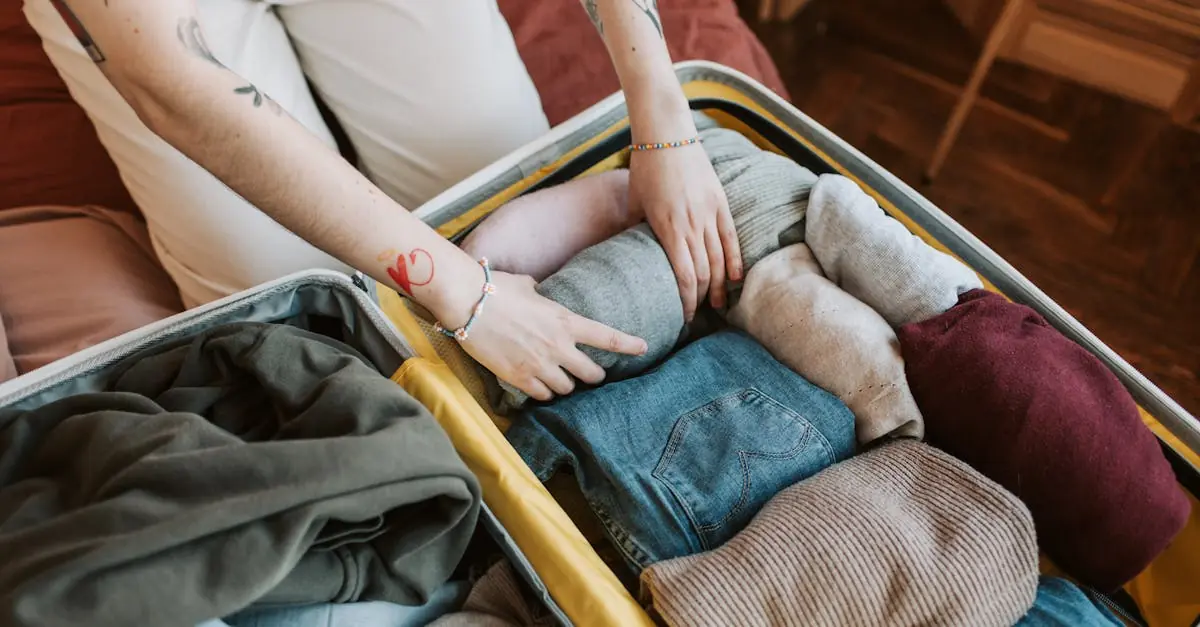Packing for a trip can feel like trying to solve a Rubik’s Cube while blindfolded. One minute you think you’ve got it all figured out, and the next, your suitcase resembles a game of Tetris gone wrong. Fear not, though! With the right packing travel tips, you can transform from a chaotic packer to a travel-savvy pro faster than you can say “jet lag.”
Table of Contents
ToggleEssential Packing Travel Tips
Packing strategically reduces stress and enhances organization. Use packing cubes to separate clothing by type or outfit. This method facilitates easy access and keeps items tidy.
Prioritize essentials by creating a checklist ahead of time. Focus on must-haves like identification, travel documents, and medications. Categorizing items aids in ensuring nothing gets left behind.
Roll clothes instead of folding them for more space and fewer wrinkles. This technique maximizes suitcase capacity and maintains the appearance of garments.
Include a resealable bag for toiletries to prevent leaks. Storing liquids and creams in this way safeguards clothing and other items from damage.
Invest in versatile clothing pieces. Select items that can be mixed and matched for various outfits, allowing for fewer overall items packed.
Wear bulky items during travel, such as jackets and boots. Doing so saves space in luggage and ensures comfort during varying weather conditions.
Evaluate the destination’s climate and tailor packing accordingly. Research average temperatures and local customs to choose appropriate clothing and gear.
Consider digital versions of guidebooks and maps to lighten the load. Utilizing e-readers or mobile devices conserves space and eases access to information on the go.
By implementing these essential packing travel tips, travelers can enhance their efficiency and enjoy a more organized journey.
Choosing the Right Luggage
Selecting the right luggage enhances travel efficiency and reduces stress during journeys. The choice of luggage varies based on travel style and destination.
Types of Luggage
Hard-shell suitcases offer durability and excellent protection for fragile items, while soft-sided options provide flexibility. Duffel bags are lightweight and ideal for short trips, easily fitting in overhead compartments. Backpacks allow hands-free movement, perfect for adventurers or city explorers. Rigid luggage often includes wheels, making transport smoother, whereas soft luggage can be expanded for additional space. Consider personal preferences and travel needs when choosing luggage type.
Size Considerations
Travelers often face limits on airline baggage dimensions, making size a crucial factor. Carry-on bags typically measure 22 x 14 x 9 inches, facilitating easy cabin storage. Larger checked luggage should comply with size restrictions, generally under 62 linear inches. Selecting luggage based on trip length ensures adequate space for clothing and essentials. Pack light for short trips, using smaller bags, while longer journeys may require more substantial options. Streamlining size facilitates easier mobility and organization throughout the travel experience.
Packing Techniques
Effective packing techniques make traveling easier and more organized. Implementing strategies like rolling clothes or utilizing packing cubes enhances space management.
Rolling vs. Folding
Rolling clothes saves space and minimizes wrinkles. This method allows for more efficient use of suitcase space while maintaining the integrity of items. Many travelers prefer this technique for T-shirts, pants, and dresses. Additionally, rolled items fit neatly into corners or gaps, maximizing available room. Some find that folding works best for structured garments, like blazers. Choosing the right method depends on personal preference and clothing type. Overall, rolling often leads to more room and less hassle when unpacking.
Utilizing Packing Cubes
Packing cubes streamline organization within luggage. These compartments separate clothing by type or outfit, making it easier to find items. A traveler might use one cube for bottoms, another for tops, and a third for accessories. This system simplifies repacking after daily excursions. Moreover, packing cubes help compress clothes, creating additional space. They also provide a visual cue for what to bring home, reducing the chance of leaving items behind. Many find that packing cubes make for a more efficient and enjoyable travel experience.
Must-Have Travel Essentials
Essential items ensure a smooth travel experience. Travelers should prioritize relevant clothing and necessary toiletries.
Clothing Items
Layering pieces accommodate varying climates and enhance outfit combinations. Versatile garments, such as lightweight jackets, may adjust from day to evening wear. Quick-dry fabrics increase comfort and minimize doing laundry during trips. Include comfortable shoes for walking and exploring, as well as sandals for relaxation. Packing a swimsuit proves beneficial, even when visiting non-beach destinations. Accessories like scarves can easily change an outfit while taking minimal space. Lastly, bring enough underwear and socks to limit laundry urgency, ideally packing for half the trip duration.
Toiletries and Accessories
Toiletries must fit within airline restrictions to avoid delays. Utilizing resealable bags ensures containment of liquids and avoids leaks. Personal items should include toothbrushes, travel-sized toothpaste, and skincare essentials. Consider packing a compact first aid kit for minor emergencies, including band-aids and pain relievers. Essentials like a charging bank support devices on the go. Sunglasses and hats offer sun protection, contributing to overall travel comfort. Selecting multipurpose items helps streamline packing and prevents excess bulk. Always include essential documents like identification and insurance cards in an easily accessible spot.
Organizing Your Packing List
Creating a well-structured packing list significantly enhances travel organization. First, consider categorizing items into specific groups such as clothing, toiletries, and essentials. Doing this streamlines both the packing process and unpacking upon arrival.
A checklist serves as a reliable tool for must-have items. By listing essentials, travelers can ensure nothing critical is forgotten. Several online resources provide templates to simplify this task.
Next, evaluate the destination’s climate and planned activities. Understanding weather patterns directs clothing choices and prevents overpacking. It’s essential to prioritize versatile items that can serve multiple purposes.
Utilizing packing cubes is beneficial for organization. Separating clothing by type or outfit simplifies finding items during the trip. Compression cubes also maximize suitcase space, allowing for more efficient packing.
Waterproof resealable bags offer protection for toiletries. Preventing leaks saves time and hassle during travel. Adhering to airline restrictions ensures compliance while packing these essentials.
Clothing should include layers and quick-dry fabrics. By prioritizing comfort and adaptability, travelers can enhance their experience. Comfortable shoes frequently become indispensable for exploring.
Remember to prepare essential documents and a compact first aid kit. This attention to detail ensures preparedness for unexpected situations. Moreover, packing multipurpose items helps streamline luggage, making travels more manageable.
Checking the packing list once ready creates confidence in packing efficiency. Each item selected plays a vital role in ensuring a smooth travel experience. Organizing effectively contributes to a stress-free journey, allowing travelers to focus on enjoyment.
Packing for travel doesn’t have to be a daunting task. By implementing effective strategies and tools, travelers can transform their packing experience into a seamless process. Utilizing packing cubes and creating a detailed checklist not only streamlines organization but also enhances efficiency.
Investing in the right luggage and prioritizing versatile clothing ensures that travelers are prepared for any adventure. With these tips in mind, packing becomes less of a chore and more of an opportunity to embrace the journey ahead. By focusing on organization and practicality, they can enjoy a stress-free travel experience and make the most of their time away.




